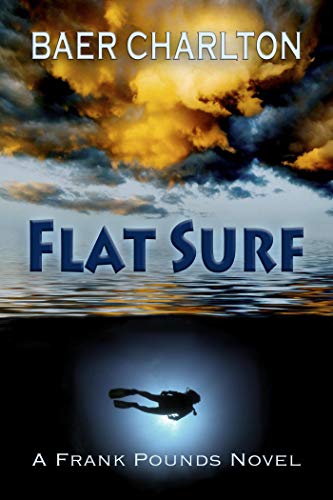Interview with Baer Charlton, Author of Flat Surf
24 Nov 2020
What can you tell us about your new release, Flat Surf?
Flat Surf kicks off a new location and character. The term “flat surf” or a surfer’s comment that the “surf is dead flat” can also be a commentary on the moment or situation.
Orange County is known for the glitz and glamour of the rich and famous. For surfers, it’s more of “where the money meets the sea.” As a setting, the old rule of thumb applies: The greater the concentration of wealth, the higher the statistical occurrence of nefarious activity. To paraphrase one who would know: “For every handful of millionaires, there is a thumb who didn’t get there legally.”
Frank Pounds was an Orange County Sheriff’s detective. An attempt on his life and killing his partner haunts his life mentally and physically. Medically retired, he is a recluse into his inherited trust and surfing. He wears his “I don’t give a fuck” attitude on his sleeve.
A body (without a head) is found on one of the more affluent beaches. Pounds is coaxed from retirement to consult because he might know the body and his intimate knowledge of the surfing world and his undisputed standing of excellence—albeit unorthodox and irreverent—at solving complex crimes.
My love for the quirkiness of Carl Hiaasen, twisted trails of Rodrick Thorpe, and the loose family building of T. Jefferson Parker gave me the rootstock to build an irreverent story about the other side of OC.
What or who inspired you to become an author?
Many greats cut their scars on my soul from an early age: Robert Louis Stevenson gave me the complex inner war with his Jekyll and Hyde; Hugo instructed me on the multifaceted face of unrequited lust with Quasimodo; Wells took me to the bottom of the ocean. And a young woman told me a strange tale of man’s obsession with creating and the monster who has his revenge on his creator. And then, I entered the fifth grade and met Hemingway.
But as for becoming a writer? It was closer to home. I learned to read by setting type for my mother. Instead of “See Dick run,” I learned Steven Armond Osofsky, Orthopedic Surgeon. As the years of evenings went by, with the mind-numbing labor of printing a single card one thousand times, Mom and I entertained ourselves by making up stories in our heads. The salient notes were cribbed on yellow five-by-seven print cards. The small stack was held together by a single red and a blue printer’s rubber bands. The stack was split in half and then faced to keep all the writing safe.
After my mother passed, my father handed me the stack saying, “I think your mother wanted you to have this.” I tossed it into the back of my desk drawer until I got a new computer. Weeding out the garbage, I found the packet. My mother typed 120wpm, was a perfect speller and grammarian, and a medical transcriber. She would type a couple of three- or four-page chatty letters on her fifteen-minute breaks. But she couldn’t bring herself to write up and submit our stories. In that, her self-doubt trumped my shyness.
As I sat in my small, rented room, I removed the rubber bands. I could smell my mother, the ink, the press oil, and the weight of our years of collaboration. My mother’s presence was powerful and inescapable. I inserted my two thumbnails and separated the stack, and a small scrap of yellow paper fluttered to the floor. I leaned over and stared at the single word written on the fool scrap. The magnitude overwhelmed me. This was the sum of my true inheritance from my mother, best friend, confidant, and mentor.
The blue ink on the yellow paper read: Publish.
With much complaining and childish whining, I submitted my first article of a sideline career as a photojournalist, stretching for decades. I sold the article a week later.
What’s on your top 5 list for the best books you’ve ever read?
Victor Hugo’s The Hunchback of Notre Dame is the greatest love and lust story to this day. From the priest’s forbidden lust for Quasimodo to Quasimodo’s pure love for Esmeralda to her lust for the captain of the guard, Hugo wove a web that no spider could build.
Mary Shelly’s Frankenstein built the complexity of human nature. The monster’s story is the teen’s lament about why they were ever born and “hating” their parents. If the youth of today were to read the original, I believe it would still resonate.
Hemingway and his The Old Man and the Sea sounds like a trope or cliché, but for me, it was a deep study of what drives people. It explained Moby Dick, The Count of Monte Cristo, and Silence of the Lambs.
More contemporary is Rodrick Thorpe’s Rainbow Drive. (Most would know his Christmas Carol and Bruce Willis throwing Hans Gruber off the tower…) What starts as a simple crime story soon becomes more of a spider’s web than China Town. About the time you think the story is wrapping up and explained, there is an auto accident, and you realize you’re not even halfway through. It was a piece d’ resistance, and he could have, or should have, stopped there.
Ken Follet grabbed me early with his Eye of the Needle, and The Eagle Has Landed. Then there were years of silence. I read a short article about him meeting a then-dying Louie L’Amour and how they roamed around Europe’s ancient sites together. It inspired him to write long-style and with a complex storyline. His tour de force encompassed power, love, lust, sin, and religion. Pillars of the Earth is, far and away, his greatest story.
Say you’re the host of a literary talk show. Who would be your first guest? What would you want to ask?
I would have to step out of the usual bookshelf and go with a great storyteller, Dolly Parton. She’s known for many things, but most see her work only as music. I want to get her take on how she transitions from emotion to story to music.
But if I could have any writer, even if dead, it would be Ernest Hemingway. No question. I would just set down the bottle and humidor on the poop deck of a sailboat and just let him open up. About the third or fifth shot, I’d start recording.
What’s your favorite thing about writing?
Killing people.
Wait. Sorry. That was one of my new characters trying to get out. If anyone was offended, I’m not responsible.
Some would call it being God, but the truth is, I only get to set things up. Once the characters are mature enough and ready to go, I get them in a room and layout the book. And then, after they have tied me to a chair and duct-taped my mouth, they tell me how I’m going to tell their story.
Sometimes having them sit on my bed in the middle of the night, stab me in the ribs with a sword or handgun, and tell me to get up and write—can be a pain. But having the characters reveal their stories, knowing they are coming from somewhere within me, is the juice. Sharing those stories with fans—that’s just icing on the cake.
What is a typical day like for you?
Boring. Cast-iron mind-numbingly routine. Up, pack my wife’s lunch, make mine, load her lunch and briefcase in her car, make breakfast… Are you sure you want to hear this?
Typically, I sneak an hour of writing in before I clean up and go to work. At work, I do the mindless stuff like edit, rewrite, throw away any bad runs up dark alleys, and listen to the characters talk about their days. And then, after the day has boiled to dried poop, and I’m about to get up from the computer and sleep—the cold muzzle of a large caliber handgun leans into the nape of my neck. There is no dialog. Everything floods in, and the fingers work their crippled dance of whatever needs to be relayed, key by key, click by click, and my eyes follow on the screen
I did not inherit the writing and typing gene from my mother. Cleaning up the raw is the long and boring job, and then my long-suffering and muchly talented editor, Rogena Mitchell-Jones, takes over with her bloody red pen. (She wanted to remove “muchly,” but I left it in because I can.)
What scene from Flat Surf was your favorite to write?
My favorite would have to be the opening scene with the coyote, which is properly pronounced coy-o-te. Every one of my books, except What About Marsha?—cowritten with Shye Ryder, has a pivotal animal. In this book, Frank Pounds has a relationship with a wild coyote. The door is open, and the bed is fair game. There is a caring humanity about coyotes, and this one was there. The suffering (or not suffering) of a battered body becoming upright and moving can only be written from experience. Getting it out of my gut was therapeutic. There is a lot of therapy in this book.
Opening a book in a nightmare and the character waking up is a badly abused trope. Turning the trope into an examination of backstory, introducing an acquired quirk, and introducing potential threat-turned-comrade, turns the trope inside out and works—unless the critics hate it.
Do you have a motto, quote, or philosophy you live by?
In 1987, the year before I was run over by a truck and lost decades of memory, I stopped at a diner in the backwoods of Oregon. I think the sign read Mom and Dad’s EAT. Their twenty-six-year-old daughter, a high functioning Down’s Syndrome, was the only waitress. She sold me on the “best coffee in town” and the best biscuits I had ever had. And then I ordered breakfast.
Somewhere while hearing their story from her mother, having way too many homemade biscuits with homemade strawberry freezer jam and bottomless coffee refills, the daughter asked me a question.
When much was lost in the fog of memory loss, the question and the sense of the log cabin diner hung in my being. It took me years to get it back to where it all belonged. It was powerful enough for me to build my tour de force book Stoneheart around.
“Are you someone I need to know or are you just passing through?”
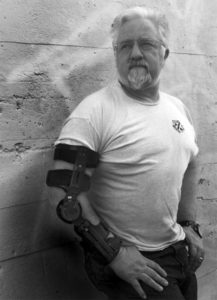
Baer Charlton is the author of the new book Flat Surf.
Connect with Baer Charlton
Author Site
Facebook
Buy The Book
Sign up for our email and we’ll send you the best new books in your favorite genres weekly.
Related
grant
Recommended Posts
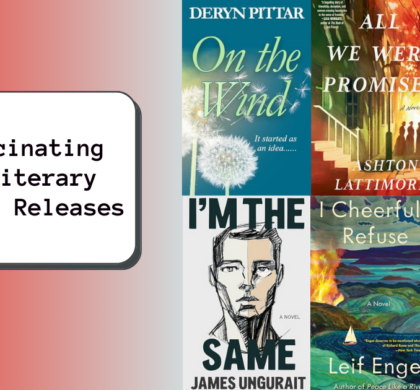
6 Fascinating New Literary Fiction Releases
12 Apr 2024 - Books to Read if You Like..., eBook, Literary Fiction, News
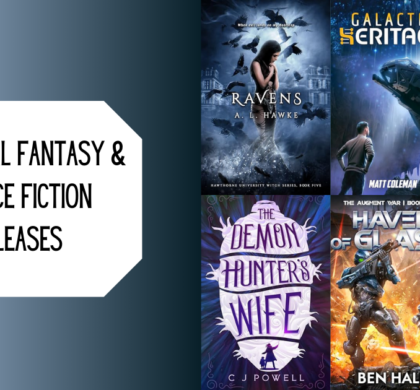
6 Surreal Fantasy and Science Fiction Releases
12 Apr 2024 - Books to Read if You Like..., eBook, Fantasy & Science Fiction, News
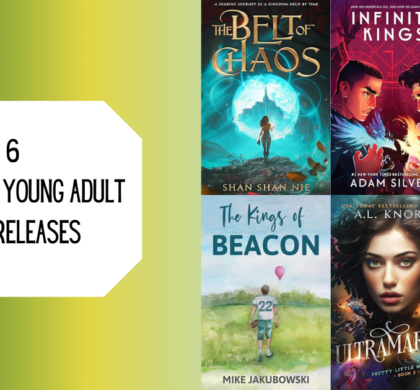
6 Whimsical Young Adult New Releases
12 Apr 2024 - Books to Read if You Like..., eBook, News, Young Adult
